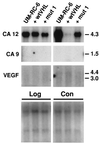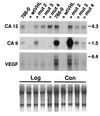Down-regulation of transmembrane carbonic anhydrases in renal cell carcinoma cell lines by wild-type von Hippel-Lindau transgenes
- PMID: 9770531
- PMCID: PMC22876
- DOI: 10.1073/pnas.95.21.12596
Down-regulation of transmembrane carbonic anhydrases in renal cell carcinoma cell lines by wild-type von Hippel-Lindau transgenes
Abstract
To discover genes involved in von Hippel-Lindau (VHL)-mediated carcinogenesis, we used renal cell carcinoma cell lines stably transfected with wild-type VHL-expressing transgenes. Large-scale RNA differential display technology applied to these cell lines identified several differentially expressed genes, including an alpha carbonic anhydrase gene, termed CA12. The deduced protein sequence was classified as a one-pass transmembrane CA possessing an apparently intact catalytic domain in the extracellular CA module. Reintroduced wild-type VHL strongly inhibited the overexpression of the CA12 gene in the parental renal cell carcinoma cell lines. Similar results were obtained with CA9, encoding another transmembrane CA with an intact catalytic domain. Although both domains of the VHL protein contribute to regulation of CA12 expression, the elongin binding domain alone could effectively regulate CA9 expression. We mapped CA12 and CA9 loci to chromosome bands 15q22 and 17q21.2 respectively, regions prone to amplification in some human cancers. Additional experiments are needed to define the role of CA IX and CA XII enzymes in the regulation of pH in the extracellular microenvironment and its potential impact on cancer cell growth.
Figures






Similar articles
-
Effects of von Hippel-Lindau gene mutation and methylation status on expression of transmembrane carbonic anhydrases in renal cell carcinoma.J Cancer Res Clin Oncol. 2002 Oct;128(10):561-8. doi: 10.1007/s00432-002-0374-x. Epub 2002 Aug 30. J Cancer Res Clin Oncol. 2002. PMID: 12384800 Free PMC article.
-
Expression of hypoxia-inducible cell-surface transmembrane carbonic anhydrases in human cancer.Am J Pathol. 2001 Mar;158(3):905-19. doi: 10.1016/S0002-9440(10)64038-2. Am J Pathol. 2001. PMID: 11238039 Free PMC article.
-
Downregulation of Cap43 gene by von Hippel-Lindau tumor suppressor protein in human renal cancer cells.Int J Cancer. 2003 Jul 20;105(6):803-10. doi: 10.1002/ijc.11152. Int J Cancer. 2003. PMID: 12767066
-
Von Hippel-Lindau disease and sporadic renal cell carcinoma.Cancer Surv. 1995;25:219-32. Cancer Surv. 1995. PMID: 8718521 Review.
-
The role of von Hippel-Lindau tumor suppressor protein and hypoxia in renal clear cell carcinoma.Am J Physiol Renal Physiol. 2004 Jul;287(1):F1-6. doi: 10.1152/ajprenal.00424.2003. Am J Physiol Renal Physiol. 2004. PMID: 15180922 Review.
Cited by
-
Expression of renal cell markers and detection of 3p loss links endolymphatic sac tumor to renal cell carcinoma and warrants careful evaluation to avoid diagnostic pitfalls.Acta Neuropathol Commun. 2018 Oct 19;6(1):107. doi: 10.1186/s40478-018-0607-0. Acta Neuropathol Commun. 2018. PMID: 30340515 Free PMC article.
-
G250: a carbonic anhydrase IX monoclonal antibody.Curr Oncol Rep. 2005 Mar;7(2):109-15. doi: 10.1007/s11912-005-0036-7. Curr Oncol Rep. 2005. PMID: 15717944 Review.
-
Hypoxia and cytokines regulate carbonic anhydrase 9 expression in hepatocellular carcinoma cells in vitro.World J Clin Oncol. 2012 Jun 10;3(6):82-91. doi: 10.5306/wjco.v3.i6.82. World J Clin Oncol. 2012. PMID: 22724087 Free PMC article.
-
Structure of the carbonic anhydrase VI (CA6) gene: evidence for two distinct groups within the alpha-CA gene family.Biochem J. 1999 Dec 1;344 Pt 2(Pt 2):385-90. Biochem J. 1999. PMID: 10567219 Free PMC article.
-
[Molecular diagnostics of renal diseases with underlying genetic predisposition].Urologe A. 2003 May;42(5):624-33. doi: 10.1007/s00120-003-0348-x. Epub 2003 Apr 8. Urologe A. 2003. PMID: 12750797 Review. German.
References
-
- Latif F, Tory K, Gnarra J, Yao M, Duh F M, Orcutt M L, Stackhouse T, Kuzmin I, Modi W, Geil L, et al. Science. 1993;260:1317–1320. - PubMed
-
- Kishida T, Stackhouse T M, Chen F, Lerman M I, Zbar B. Cancer Res. 1995;55:4544–4548. - PubMed
-
- Duan D R, Pause A, Burgess W H, Aso T, Chen D Y, Garrett K P, Conaway R C, Conaway J W, Linehan W M, Klausner R D. Science. 1995;269:1402–1406. - PubMed
-
- Kibel A, Iliopoulos O, DeCaprio J A, Kaelin W G., Jr Science. 1995;269:1444–1446. - PubMed
Publication types
MeSH terms
Substances
Associated data
- Actions
Grants and funding
LinkOut - more resources
Full Text Sources
Other Literature Sources
Medical
Molecular Biology Databases

